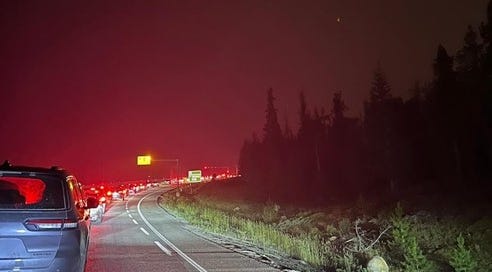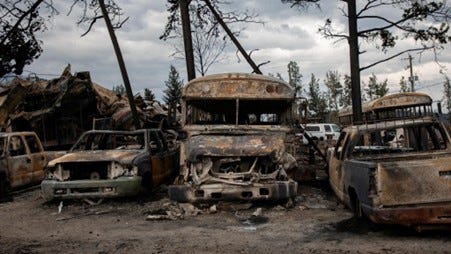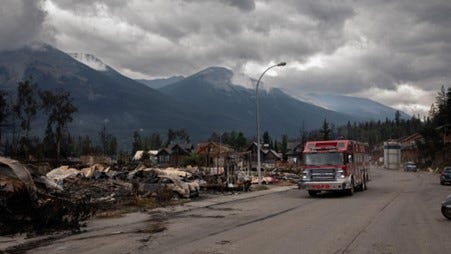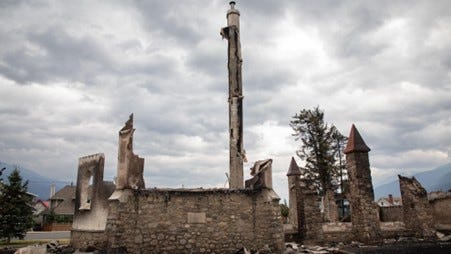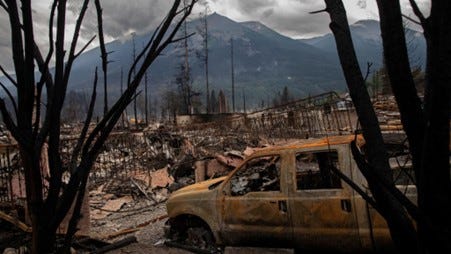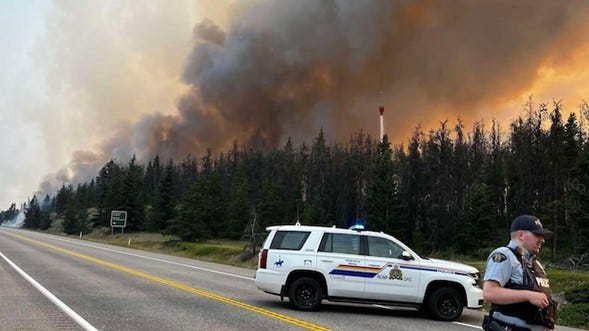The forest fires in Jasper (Alberta) – July 2024
[Another small surge in subscribers – from Whitley Bay and Settle, amongst others. This post is specifically aimed at the AQA A Level specification, though might be useful to others.
It is likely to be the last post for a couple of weeks. For all subscribers, there is, however, a large archive to look through on the app.
You could also catch up with other excellent Substacks, such as that of Hannah Ritchie – see this post today on climate change, feedback mechanisms, carbon footprint and carbon handprint here. ]
In July 2024, the largest National Park in the Canadian Rockies, Jasper, was hit by a wildfire that caused extensive damage and forced 25,000 people to evacuate. The fire broke out on the southern part of the town, and several buildings and other infrastructure were affected. Significant damage has also been done to the Park.
Lying north of the more popular Banff National Park, Jasper National Park is the largest in Canada's Rocky Mountains, at over 11,000 square kilometres. The UNESCO World Heritage Site is home to elk, grizzly bear, moose and bison. The town of Jasper has a population of about 5,000 but has several hotels to accommodate the roughly 2.5 million people who pass through to visit the park every year.
During the evacuation, 245 hikers were either picked up or helped to leave the park. Helicopter crews flew low along the trails, working to airlift stranded hikers or direct them toward a safer trail.
Following a heatwave that lasted 3 weeks in June and July and over 58,000 lightning strikes in one week alone, new fires were easily started. A firewall of up to 100m spread through the area and town. Around 1,900 Alberta firefighters were deployed, assisted by personnel from Alaska and Australia, and worked to save local infrastructure. There were concerns regarding air quality in nearby cities such as Calgary as other fires burned in the states of Alberta and British Columbia.
With wildfires cutting off highway access east to Edmonton and south along the Icefields Parkway, many evacuees were forced west into British Columbia. They were later redirected east to Alberta. Reception centres were set up in the cities of Grande Prairie, Calgary and Edmonton, where evacuees were helped with accommodation.
Evacuees from Jasper, Alberta, clog the highway early in a morning.
Image source: The Canadian Press/Ho-X/@_CLCAMPBELL
Image source: Reuters
Authorities from Jasper National Park said over 350 of the thousand structures in the town had been destroyed by the fire. However, all critical infrastructure was protected, including the hospital, library and firehall.
One local who lost his home is Jasper Mayor Richard Ireland. When he stood in front of what remained of his home, reduced to a few charred cement blocks, he said: ‘Now, it’s just memories of family and fire.’ He spoke of a photograph lost to the flames, where he was just a two-year-old sitting on some boxes next to a birthday cake at that very house. He had lived at the same address for 67 years.
Image source: Reuters
The remains of a church. Image source: Reuters
Image source: Reuters
It is difficult to say how long it will take to restore the town, or indeed the pristine ecology that helps make the Park one of the prides of Canada.
Image source: Trina Pelland Taylor

